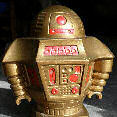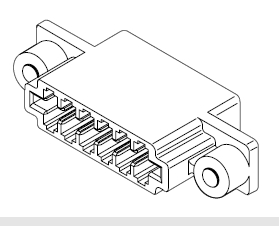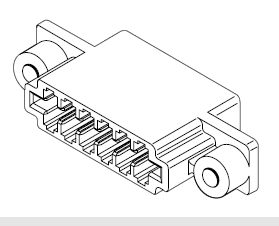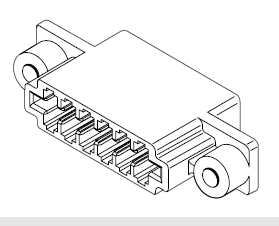 |
Matronics Email Lists
Web Forum Interface to the Matronics Email Lists
|
| View previous topic :: View next topic |
| Author |
Message |
Eric M. Jones

Joined: 10 Jan 2006
Posts: 565
Location: Massachusetts
|
 Posted: Wed Aug 18, 2010 4:44 am Post subject: Tray Connectors...A Bad Idea. Posted: Wed Aug 18, 2010 4:44 am Post subject: Tray Connectors...A Bad Idea. |
 |
|
I am sure the notion of sliding a piece of electronics into a tray with the connector on the back has some informative design history, but it is a horrible idea for aircraft (and even cars). In general you should avoid it and replace the connector with a hanging one where the connections aren't attached to two separately moving bodies.
| | - The Matronics AeroElectric-List Email Forum - | | | Use the List Feature Navigator to browse the many List utilities available such as the Email Subscriptions page, Archive Search & Download, 7-Day Browse, Chat, FAQ, Photoshare, and much more:
http://www.matronics.com/Navigator?AeroElectric-List |
|
_________________
Eric M. Jones
www.PerihelionDesign.com
113 Brentwood Drive
Southbridge, MA 01550
(508) 764-2072
emjones(at)charter.net |
|
| Back to top |
|
 |
sportav8r(at)gmail.com
Guest
|
 Posted: Wed Aug 18, 2010 7:04 am Post subject: Tray Connectors...A Bad Idea. Posted: Wed Aug 18, 2010 7:04 am Post subject: Tray Connectors...A Bad Idea. |
 |
|
Given my experience with an elusive transponder intermittent caused by a mechanically unsound tray-mounted coax bulkhead connector, I tend to agree with your assessment. Just not clear on how you achieve this without doing surgery on the avionics sure to void the warranty. Do you have a how-to on remoting the connectors on the back of avionis boxes into pigtails, Eric? I'd like to see how you implement this idea.
-Bill B
On Wed, Aug 18, 2010 at 8:44 AM, Eric M. Jones <emjones(at)charter.net (emjones(at)charter.net)> wrote:
[quote] --> AeroElectric-List message posted by: "Eric M. Jones" <emjones(at)charter.net (emjones(at)charter.net)>
I am sure the notion of sliding a piece of electronics into a tray with the connector on the back has some informative design history, but it is a horrible idea for aircraft (and even cars). In general you should avoid it and replace the connector with a hanging one where the connections aren't attached to two separately moving bodies.
--------
Eric M. Jones
www.PerihelionDesign.com
113 Brentwood Drive
Southbridge, MA 01550
(508) 764-2072
emjones(at)charter.net (emjones(at)charter.net)
Read this topic online here:
http://forums.matronics.com/viewtopic.php?p=309261#309261
===========
-List" target="_blank">http://www.matronics.com/Navigator?AeroElectric-List
===========
http://forums.matronics.com
===========
le, List Admin.
="_blank">http://www.matronics.com/contribution
===========
[b]
| | - The Matronics AeroElectric-List Email Forum - | | | Use the List Feature Navigator to browse the many List utilities available such as the Email Subscriptions page, Archive Search & Download, 7-Day Browse, Chat, FAQ, Photoshare, and much more:
http://www.matronics.com/Navigator?AeroElectric-List |
|
|
|
| Back to top |
|
 |
Eric M. Jones

Joined: 10 Jan 2006
Posts: 565
Location: Massachusetts
|
 Posted: Thu Aug 19, 2010 9:20 am Post subject: Re: Tray Connectors...A Bad Idea. Posted: Thu Aug 19, 2010 9:20 am Post subject: Re: Tray Connectors...A Bad Idea. |
 |
|
Bill,
I don't have any specific plans, but I've seen the problem and experienced it. I suppose one could demount the female connector, fasten it to the back of the avionics box and male connector and add a cannon round connector (or such).
Your mileage may vary.
Eric
| | - The Matronics AeroElectric-List Email Forum - | | | Use the List Feature Navigator to browse the many List utilities available such as the Email Subscriptions page, Archive Search & Download, 7-Day Browse, Chat, FAQ, Photoshare, and much more:
http://www.matronics.com/Navigator?AeroElectric-List |
|
_________________
Eric M. Jones
www.PerihelionDesign.com
113 Brentwood Drive
Southbridge, MA 01550
(508) 764-2072
emjones(at)charter.net |
|
| Back to top |
|
 |
nuckolls.bob(at)aeroelect
Guest
|
 Posted: Sat Aug 21, 2010 10:28 am Post subject: Tray Connectors...A Bad Idea. Posted: Sat Aug 21, 2010 10:28 am Post subject: Tray Connectors...A Bad Idea. |
 |
|
At 07:44 AM 8/18/2010, you wrote:
| Quote: | --> AeroElectric-List message posted by: "Eric M. Jones" <emjones(at)charter.net>
I am sure the notion of sliding a piece of electronics into a tray with the connector on the back has some informative design history, but it is a horrible idea for aircraft (and even cars). In general you should avoid it and replace the connector with a hanging one where the connections aren't attached to two separately moving bodies. |
It's true that connectors at the rear of
slide-in accessories mating with connectors
on captive trays have extra-ordinary design
requirements. And there were a few radios
wherein the designers had to learn the
weaknesses in the worst way - field experience.
Many of the first radios for GA aircraft didn't
even mount on the panel. Take this cute little
feller . . .
http://tinyurl.com/29sfmdd
This radio was battery powered and not intended
to be mounted solidly to the airplane. See the
leather carrying handle? One sat it in the seat,
plugged in an antenna, headphones and mic and voila!
You had an airborne radio communications system.
The antenna was in fact, a device adapted from a
car radio installation. You talked on a VHF frequency
determined by which crystal you plugged into the
panel (see slots for two other frequencies)
and listened for the ground facility to
reply over the local radio range, LF beacon
or marker transmitter.
Not too many years after, folks began to find
ways to mount these new fangled devices to the
panel and it didn't take long to realize that
it was MUCH easier to do installation and maintenance
if the mounting tray and harness was captive
to the airplane and the radio simply slides into
the tray. Exemplar radios included this device.
http://tinyurl.com/29hm578
You can see the head of the radio-to-tray
jackscrew at the upper edge of the LF receiver
bezel.
http://tinyurl.com/2c5hu4w
The other end of the jackscrew can be seen
here along with the Cinch-Jones connectors
that mated with connectors captive to the
tray. These connectors are still in production.
http://tinyurl.com/yhm37ow
At the same time, other manufacturers elected
not to participate in that adventure. As I
recall, this radio's installation tray
http://tinyurl.com/3xklhct
did not capture the mating connectors. The
maintenance person had to crawl under the
panel to mate/de-mate harnesses with the
radio.
Even today, the installed size and wire-count
of some radios . . .
http://tinyurl.com/2u58jrb
doesn't offer practical tray designs and
their mating harness connectors are captive
directly to the radio chassis.
Aircraft radios did suffer a sort of "dark
ages" when connectors intended to engage card-
edge fingers were pressed into service on
new designs. King radio (and others) built a
LOT of devices that used this genre' of wire
to board connector:
[img]cid:.0[/img]
That accepted pins looking like this:
[img]cid:.0[/img]
At Cessna in 1963 or so, we did an audio distribution
board that mounted some relays and provided a sort
of junction box for integrating a stack of radios
into the single-engine product line.
The card-edge connector was imply not designed to
perform well in the aircraft environment. The
in-house experiment only lasted a few years. Recall
that good connection science calls for low surface
area, high-pressure contact between pin and socket.
The thin, gold-plated fingers of soft copper and the
wide, low pressure springs in the pins simply did
not rise to the task. Further, these connectors are
probably the most fragile interconnect devices
ever. They are entirely suited for SOME limited
applications and are still made . . . but you won't
(or at least shouldn't) find them in a product
destined for use in an airplane.
These connectors are not well contained. Dust
laden with moisture, oils, and grit can accumulate
over time. There's no wire support to keep harness
wiggles from "working" the pins in their housings.
I'd venture a guess that 90+ percent of my
observations of "connector grief" with panel mounted
radios in light aircraft have involved a variant
of a card-edge-to-wire product.
Having said that, I'm not sure I'd recommend a
great migration to modifying any radio that's still
in service utilizing this connector style. It
would probably be useful to install new pins in
all the holes. Clean the card edge fingers
with a solvent wetted swab (resist any
temptation to buff with ANY form of abrasive),
that gold plating is VERY thin! Then provide
bundle support for the wires close to where
they exit the connector housing.
Beyond this example of mis-applied technologies,
I think the researcher will find that tray
mounted harness connectors have enjoyed secure,
happy and long lived associations with their
radio mounted mates. The design has been widely
practiced over the full range of avionics from
the present day descendant of the Mitchell Airboy up
to and including electro-whizzies in military
and spacecraft.
The magic happens when the connector pin-socket
combinations are truly crafted to the task,
harnesses don't hang from the pin's insulation
grip, housings do a good job of shielding pins
from the environmental crud, and finally, the
radio is properly captive in the tray by proper
tightening of the retaining hardware.
By the way, if any of you are interested in a
little museum trip down Avionics Lane, I'll invite
you to look over the collection of pictures here:
http://aeroelectric.com/Pictures/Radios/
Some of us grey beards have had the pleasure
of cranking on a few of these very same knobs.
My first flying lesson in a rudder-pedal fitted
included a how-to session on one of these:
http://tinyurl.com/3xklhct
Bob . . .
| | - The Matronics AeroElectric-List Email Forum - | | | Use the List Feature Navigator to browse the many List utilities available such as the Email Subscriptions page, Archive Search & Download, 7-Day Browse, Chat, FAQ, Photoshare, and much more:
http://www.matronics.com/Navigator?AeroElectric-List |
|
| Description: |
|
| Filesize: |
28.89 KB |
| Viewed: |
5240 Time(s) |

|
|
|
| Back to top |
|
 |
ralphmariafinch(at)gmail.
Guest
|
 Posted: Sat Aug 21, 2010 11:02 am Post subject: Tray Connectors...A Bad Idea. Posted: Sat Aug 21, 2010 11:02 am Post subject: Tray Connectors...A Bad Idea. |
 |
|
Bob-you are the man. Your knowledge and *understanding* of both electrical
issues and their history of development is truly remarkable and seldom seen
nowadays in any field. Old School of the best kind.
A tip-of-the-hat from
Ralph Finch
Davis, California, USA
RV-9A QB-SA
| | - The Matronics AeroElectric-List Email Forum - | | | Use the List Feature Navigator to browse the many List utilities available such as the Email Subscriptions page, Archive Search & Download, 7-Day Browse, Chat, FAQ, Photoshare, and much more:
http://www.matronics.com/Navigator?AeroElectric-List |
|
|
|
| Back to top |
|
 |
MauleDriver(at)nc.rr.com
Guest
|
 Posted: Sat Aug 21, 2010 11:36 am Post subject: Tray Connectors...A Bad Idea. Posted: Sat Aug 21, 2010 11:36 am Post subject: Tray Connectors...A Bad Idea. |
 |
|
I knew when this was posted it would generate an interesting dialog but
didn't expect an avionics history lesson. Great stuff! Thanks Bob and
Eric.
Robert L. Nuckolls, III wrote:
| Quote: | At 07:44 AM 8/18/2010, you wrote:
>
> <emjones(at)charter.net>
>
> I am sure the notion of sliding a piece of electronics into a tray
> with the connector on the back has some informative design history,
> but it is a horrible idea for aircraft (and even cars). In general
> you should avoid it and replace the connector with a hanging one
> where the connections aren't attached to two separately moving bodies.
It's true that connectors at the rear of
slide-in accessories mating with connectors
on captive trays have extra-ordinary design
requirements. And there were a few radios
wherein the designers had to learn the
weaknesses in the worst way - field experience.
Many of the first radios for GA aircraft didn't
even mount on the panel. Take this cute little
feller . . .
* http://tinyurl.com/29sfmdd*
This radio was battery powered and not intended
snippety snip
|
| | - The Matronics AeroElectric-List Email Forum - | | | Use the List Feature Navigator to browse the many List utilities available such as the Email Subscriptions page, Archive Search & Download, 7-Day Browse, Chat, FAQ, Photoshare, and much more:
http://www.matronics.com/Navigator?AeroElectric-List |
|
|
|
| Back to top |
|
 |
BobsV35B(at)aol.com
Guest
|
 Posted: Sat Aug 21, 2010 1:03 pm Post subject: Tray Connectors...A Bad Idea. Posted: Sat Aug 21, 2010 1:03 pm Post subject: Tray Connectors...A Bad Idea. |
 |
|
Good Afternoon 'Lectric Bob.
And prior to that ultra modern Mitchel VHF set, we used Bill Lear's portable in a small suitcase which transmitted on 3105kc and allowed us to receive the "Beam" on low frequency. It even had a built in loop antenna. We could rotate the whole radio and get a bearing to or from the station. With a little judicious maneuvering, we could figure out whether the station was ahead or behind us in a as little as ten minutes or so.
The biggest problem with it was finding a long wire antenna. With such an antenna, we could talk to a tower from as far as fifteen miles away. Great stuff.
Happy Skies,
Old Bob
In a message dated 8/21/2010 1:29:29 P.M. Central Daylight Time, nuckolls.bob(at)aeroelectric.com writes:
| Quote: | At 07:44 AM 8/18/2010, you wrote:
| Quote: | --> AeroElectric-List message posted by: "Eric M. Jones" <emjones(at)charter.net>
I am sure the notion of sliding a piece of electronics into a tray with the connector on the back has some informative design history, but it is a horrible idea for aircraft (and even cars). In general you should avoid it and replace the connector with a hanging one where the connections aren't attached to two separately moving bodies. |
It's true that connectors at the rear of
slide-in accessories mating with connectors
on captive trays have extra-ordinary design
requirements. And there were a few radios
wherein the designers had to learn the
weaknesses in the worst way - field experience.
Many of the first radios for GA aircraft didn't
even mount on the panel. Take this cute little
feller . . .
http://tinyurl.com/29sfmdd
This radio was battery powered and not intended
to be mounted solidly to the airplane. See the
leather carrying handle? One sat it in the seat,
plugged in an antenna, headphones and mic and voila!
You had an airborne radio communications system.
The antenna was in fact, a device adapted from a
car radio installation. You talked on a VHF frequency
determined by which crystal you plugged into the
panel (see slots for two other frequencies)
and listened for the ground facility to
reply over the local radio range, LF beacon
or marker transmitter.
Not too many years after, folks began to find
ways to mount these new fangled devices to the
panel and it didn't take long to realize that
it was MUCH easier to do installation and maintenance
if the mounting tray and harness was captive
to the airplane and the radio simply slides into
the tray. Exemplar radios included this device.
http://tinyurl.com/29hm578
You can see the head of the radio-to-tray
jackscrew at the upper edge of the LF receiver
bezel.
http://tinyurl.com/2c5hu4w
The other end of the jackscrew can be seen
here along with the Cinch-Jones connectors
that mated with connectors captive to the
tray. These connectors are still in production.
http://tinyurl.com/yhm37ow
At the same time, other manufacturers elected
not to participate in that adventure. As I
recall, this radio's installation tray
http://tinyurl.com/3xklhct
did not capture the mating connectors. The
maintenance person had to crawl under the
panel to mate/de-mate harnesses with the
radio.
Even today, the installed size and wire-count
of some radios . . .
http://tinyurl.com/2u58jrb
doesn't offer practical tray designs and
their mating harness connectors are captive
directly to the radio chassis.
Aircraft radios did suffer a sort of "dark
ages" when connectors intended to engage card-
edge fingers were pressed into service on
new designs. King radio (and others) built a
LOT of devices that used this genre' of wire
to board connector:
That accepted pins looking like this:
At Cessna in 1963 or so, we did an audio distribution
board that mounted some relays and provided a sort
of junction box for integrating a stack of radios
into the single-engine product line.
The card-edge connector was imply not designed to
perform well in the aircraft environment. The
in-house experiment only lasted a few years. Recall
that good connection science calls for low surface
area, high-pressure contact between pin and socket.
The thin, gold-plated fingers of soft copper and the
wide, low pressure springs in the pins simply did
not rise to the task. Further, these connectors are
probably the most fragile interconnect devices
ever. They are entirely suited for SOME limited
applications and are still made . . . but you won't
(or at least shouldn't) find them in a product
destined for use in an airplane.
These connectors are not well contained. Dust
laden with moisture, oils, and grit can accumulate
over time. There's no wire support to keep harness
wiggles from "working" the pins in their housings.
I'd venture a guess that 90+ percent of my
observations of "connector grief" with panel mounted
radios in light aircraft have involved a variant
of a card-edge-to-wire product.
Having said that, I'm not sure I'd recommend a
great migration to modifying any radio that's still
in service utilizing this connector style. It
would probably be useful to install new pins in
all the holes. Clean the card edge fingers
with a solvent wetted swab (resist any
temptation to buff with ANY form of abrasive),
that gold plating is VERY thin! Then provide
bundle support for the wires close to where
they exit the connector housing.
Beyond this example of mis-applied technologies,
I think the researcher will find that tray
mounted harness connectors have enjoyed secure,
happy and long lived associations with their
radio mounted mates. The design has been widely
practiced over the full range of avionics from
the present day descendant of the Mitchell Airboy up
to and including electro-whizzies in military
and spacecraft.
The magic happens when the connector pin-socket
combinations are truly crafted to the task,
harnesses don't hang from the pin's insulation
grip, housings do a good job of shielding pins
from the environmental crud, and finally, the
radio is properly captive in the tray by proper
tightening of the retaining hardware.
By the way, if any of you are interested in a
little museum trip down Avionics Lane, I'll invite
you to look over the collection of pictures here:
http://aeroelectric.com/Pictures/Radios/
Some of us grey beards have had the pleasure
of cranking on a few of these very same knobs.
My first flying lesson in a rudder-pedal fitted
included a how-to session on one of these:
http://tinyurl.com/3xklhct
Bob . . . |
| | - The Matronics AeroElectric-List Email Forum - | | | Use the List Feature Navigator to browse the many List utilities available such as the Email Subscriptions page, Archive Search & Download, 7-Day Browse, Chat, FAQ, Photoshare, and much more:
http://www.matronics.com/Navigator?AeroElectric-List |
|
| Description: |
|
| Filesize: |
28.89 KB |
| Viewed: |
5235 Time(s) |

|
| Description: |
|
| Filesize: |
28.89 KB |
| Viewed: |
5235 Time(s) |

|
|
|
| Back to top |
|
 |
nuckolls.bob(at)aeroelect
Guest
|
 Posted: Sat Aug 21, 2010 1:16 pm Post subject: Tray Connectors...A Bad Idea. Posted: Sat Aug 21, 2010 1:16 pm Post subject: Tray Connectors...A Bad Idea. |
 |
|
At 02:01 PM 8/21/2010, you wrote:
| Quote: |
<ralphmariafinch(at)gmail.com>
Bob-you are the man. Your knowledge and *understanding* of both electrical
issues and their history of development is truly remarkable and seldom seen
nowadays in any field. Old School of the best kind.
|
Thank you Ralph. Unfortunately, it just may be
'old school'. Now that I'm "out in the wild" myself
I'm observing what might just be a cultural shift
in the reverence for history. Most folks exposures
to the study of history involves the memorization
of names, places, dates and events.
I've benefited from the study of practical history.
What recipes for success have been demonstrated in
the past . . . and what can we glean from those stories
for (1) not having to re-invent the wheel, (2) discovery
of those timeless, simple-ideas that are equally
applicable but perhaps in a different recipe? A sort
of connect-the-dots exercise that improves upon one's
situational awareness.
To forsake an understanding the past leads
to a sort of intellectual entropy. Even as the
magnitude of activity increases, so does the
quantity of smoke and steam. Smoke from by-products
of combustion, steam as a manifestation of energy
needed to convert water to vapor. Both byproducts
representing value expended never to be recovered.
Sharing of practical history amongst folks on this
and similar lists goes a long way to the reduction
of smoke and steam while maximizing the value of
what happens in our workshops. It's my pleasure
to exercise these talents but without the list,
that exercise is at risk of becoming only more
smoke and steam. I thank you all for being there.
Bob . . .
| | - The Matronics AeroElectric-List Email Forum - | | | Use the List Feature Navigator to browse the many List utilities available such as the Email Subscriptions page, Archive Search & Download, 7-Day Browse, Chat, FAQ, Photoshare, and much more:
http://www.matronics.com/Navigator?AeroElectric-List |
|
|
|
| Back to top |
|
 |
|
|
You cannot post new topics in this forum
You cannot reply to topics in this forum
You cannot edit your posts in this forum
You cannot delete your posts in this forum
You cannot vote in polls in this forum
You cannot attach files in this forum
You can download files in this forum
|
Powered by phpBB © 2001, 2005 phpBB Group
|





